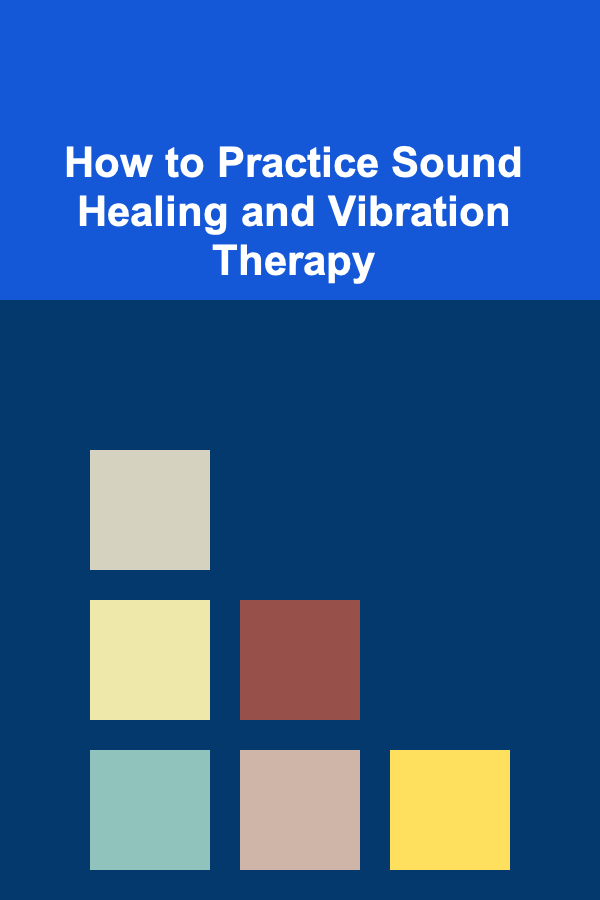
How to Practice Sound Healing and Vibration Therapy
ebook include PDF & Audio bundle (Micro Guide)
$12.99$5.99
Limited Time Offer! Order within the next:

Sound healing and vibration therapy are ancient practices that have recently experienced a resurgence in popularity due to their profound healing effects on both the mind and body. These therapies harness the power of sound frequencies and vibrations to promote physical, emotional, and spiritual well-being. This article will explore the principles, techniques, benefits, and practical applications of sound healing and vibration therapy, offering a comprehensive guide to understanding and practicing these powerful modalities.
Understanding Sound Healing and Vibration Therapy
The Science of Sound and Vibration
Sound healing and vibration therapy are based on the understanding that everything in the universe, including our bodies, is composed of energy that vibrates at specific frequencies. The concept is rooted in the idea that sound frequencies can influence these vibrations, leading to a state of balance and healing. Our bodies are made up of cells, tissues, and organs that resonate at particular frequencies. When these frequencies are disrupted---due to stress, illness, or trauma---the body may experience imbalances that affect overall health.
Sound healing utilizes specific sound frequencies to restore harmony to the body's energy field. These frequencies can help reduce stress, alleviate pain, and promote emotional healing. Vibration therapy, closely related to sound healing, works by applying physical vibrations to the body. These vibrations stimulate cells and tissues, promoting circulation, detoxification, and tissue regeneration.
The Role of Frequency in Healing
Everything in the universe has its own natural frequency. This includes not only the planets, plants, and animals, but also human beings. Our cells and organs vibrate at their own resonant frequencies, and when these frequencies are in harmony, our bodies are healthy and functioning optimally. However, various factors such as stress, injury, and negative emotions can cause these frequencies to fall out of sync.
In sound healing, specific frequencies are used to restore balance to the body's vibrations. These frequencies may be in the form of sound waves, musical tones, or even binaural beats (two different frequencies played in each ear to produce a perceived third frequency). The goal is to align the body's energy and vibrations with those of healing frequencies.
The History of Sound Healing
The use of sound for healing dates back thousands of years and spans across various ancient civilizations. The Egyptians, Greeks, and Chinese all had methods of using sound as a tool for healing. Ancient temples often featured resonant spaces designed to amplify sound, allowing the vibrations to heal both the body and the spirit.
The most famous example of sound healing in history is the use of gongs, singing bowls, and other instruments in traditional medicine practices in India, Tibet, and China. These instruments, which emit particular sound frequencies, have been used for centuries to heal the body and restore spiritual balance. In the 20th century, the modern sound healing movement began, with pioneers like Dr. Hans Jenny exploring the effects of sound frequencies on matter, particularly in his work with cymatics.
The Benefits of Sound Healing and Vibration Therapy
Sound healing and vibration therapy offer a wide range of benefits for physical, emotional, and spiritual well-being. These benefits can be categorized into several key areas:
1. Physical Healing and Pain Relief
Sound and vibration therapy can help alleviate physical pain by promoting relaxation and reducing muscle tension. The vibrations from sound waves can stimulate the body's natural healing processes, improving circulation and encouraging tissue regeneration. This can be particularly helpful for individuals dealing with chronic pain conditions such as arthritis, fibromyalgia, and muscle soreness.
Studies have shown that sound frequencies can have a therapeutic effect on various parts of the body. For example, certain frequencies have been found to help break up scar tissue, reduce inflammation, and even stimulate the production of collagen, which is essential for tissue repair.
2. Stress Reduction and Relaxation
One of the most immediate benefits of sound healing is its ability to induce deep relaxation. Listening to soothing sound frequencies can lower the body's production of stress hormones such as cortisol, while simultaneously increasing the release of relaxation hormones like serotonin and dopamine. As a result, sound healing can help reduce feelings of anxiety, tension, and mental fatigue.
Therapists often use sound frequencies to guide clients into a meditative or trance-like state. This can provide relief from emotional stress, promote mental clarity, and even improve sleep quality. The rhythmic nature of sound can also help synchronize brainwave patterns, leading to improved focus and cognitive performance.
3. Emotional Healing
Sound healing is particularly effective at addressing emotional imbalances. Certain frequencies are believed to help release blocked emotions and traumas that have been stored in the body. Sound therapy can encourage emotional catharsis, allowing individuals to process unresolved feelings and heal past wounds.
Vibration therapy can help activate the body's energy centers, such as the chakras, allowing energy to flow freely and facilitating emotional release. Many people find that regular sound healing sessions improve their overall mood, increase their sense of well-being, and help them navigate difficult emotions more effectively.
4. Spiritual Growth and Meditation
Sound healing is often used as a tool for spiritual growth and transformation. In many cultures, sound is believed to have a direct connection to the divine, and its vibrations can help individuals align with their higher selves. Through sound healing, individuals can tap into deeper states of consciousness and access spiritual wisdom.
The practice of using sound to meditate can help clear the mind, increase focus, and deepen one's spiritual connection. Instruments such as Tibetan singing bowls, gongs, and tuning forks are often used to guide individuals into altered states of consciousness, promoting inner peace and spiritual awakening.
How to Practice Sound Healing and Vibration Therapy
While sound healing and vibration therapy are typically practiced by trained therapists or practitioners, it is also possible to incorporate these techniques into your own life for personal healing. The following methods will guide you through the process of practicing sound healing and vibration therapy.
1. Using Sound Healing Instruments
Various instruments are used in sound healing to produce specific frequencies that resonate with the body. These instruments include:
- Singing Bowls: Tibetan singing bowls, crystal bowls, and metal bowls are commonly used in sound healing. The vibrations produced by these bowls are thought to activate the body's energy centers and promote healing.
- Gongs: Gongs produce deep, resonant sounds that have a powerful effect on the body and mind. They are often used to help clear energetic blockages and promote deep relaxation.
- Tuning Forks: These are handheld tools that produce specific sound frequencies when struck. Tuning forks can be used to balance the body's energy and promote healing on a cellular level.
- Drums: Drumming is an ancient practice used to create rhythm and vibration. The repetitive sound of a drum can help induce a trance-like state, promoting deep healing and relaxation.
- Chimes: Wind chimes or handheld chimes produce soft, melodic sounds that can promote mental clarity and emotional release.
2. Listening to Healing Music and Frequencies
If you do not have access to sound healing instruments, you can still practice sound healing by listening to pre-recorded healing music and frequencies. There are numerous audio tracks available online that feature binaural beats, solfeggio frequencies, and other therapeutic sounds.
- Binaural Beats: These are two slightly different frequencies played in each ear, which the brain perceives as a third frequency. Binaural beats can be used to promote relaxation, focus, or even altered states of consciousness.
- Solfeggio Frequencies: These are specific tones that are believed to have healing properties. Each frequency is associated with a different aspect of healing, such as emotional balance, physical well-being, and spiritual growth.
- Nature Sounds: Listening to recordings of nature sounds, such as ocean waves, rain, or birdsong, can be incredibly soothing and help you connect with the natural world.
3. Vibration Therapy Using Body Techniques
In addition to sound therapy, vibration therapy can be applied directly to the body through physical techniques. These methods help stimulate the cells and tissues, improving circulation and promoting healing.
- Vibrational Massage: This involves using handheld vibrational devices or massagers to apply vibrations directly to the skin. These devices are designed to stimulate muscles, reduce tension, and promote the movement of lymphatic fluid.
- Body Tuning: This technique involves using tuning forks or other vibrational tools on specific areas of the body. By placing the tuning forks on acupuncture points or energy centers, practitioners can encourage the flow of energy and promote healing.
4. Guided Meditation with Sound
To practice sound healing in a meditative setting, you can use sound as a tool to guide you into deep states of relaxation. Here is a simple process to get started:
- Find a Quiet Space: Choose a calm, quiet space where you won't be disturbed. Sit or lie down in a comfortable position.
- Choose Your Sound: Select a sound healing instrument or audio that resonates with you. You can use singing bowls, gongs, or even binaural beats.
- Focus on Your Breath: Begin by taking deep, slow breaths to relax your body and mind.
- Let the Sound Guide You: Close your eyes and allow the sound to fill your space. Focus on the vibrations and let them guide you into a deeper state of consciousness. Allow any thoughts or emotions to come and go without attachment.
- End with Gratitude: After your session, take a moment to express gratitude for the healing that has taken place.
5. Creating a Sound Healing Ritual
To incorporate sound healing into your daily routine, consider creating a sound healing ritual. This can be as simple as spending a few minutes each day listening to healing frequencies or using sound healing instruments. Over time, you will begin to experience the profound benefits of these practices in your life.
Conclusion
Sound healing and vibration therapy are powerful tools for promoting physical, emotional, and spiritual well-being. By understanding the science behind these therapies and learning how to incorporate them into your daily routine, you can harness their transformative effects to heal and restore balance in your life. Whether you are seeking relief from pain, reducing stress, or deepening your spiritual connection, sound healing and vibration therapy offer an accessible and effective pathway to healing.

How to Create a Checklist for Preparing Your Presentation Speech
Read More
How to Organize the Ultimate Dinner Party at Home
Read More
How to Organize Your Time for Stress-Free Living
Read More
Smart Strategies for Cutting Down on Personal Care Services Without Sacrificing Quality
Read More
The Art of Electrical Engineering: Designing Efficient and Sustainable Systems
Read More
What Are the Key Steps to Organizing Family Photos?
Read MoreOther Products

How to Create a Checklist for Preparing Your Presentation Speech
Read More
How to Organize the Ultimate Dinner Party at Home
Read More
How to Organize Your Time for Stress-Free Living
Read More
Smart Strategies for Cutting Down on Personal Care Services Without Sacrificing Quality
Read More
The Art of Electrical Engineering: Designing Efficient and Sustainable Systems
Read More